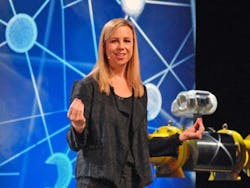“Often, what they say they do and what they actually do are two very different things.” Honeywell’s Alicia Kempf on how they used interviews with operators—and observations of their behavior—in researching user needs for a next-generation batch automation system.
Henry Ford and Steve Jobs were leery of asking customers what they want—Ford thought they would ask for better horses, and Jobs said they didn’t know what they wanted until you showed it to them. So, Honeywell took a different approach to bring “the voice of the customer” into the design of its new Experion Batch control system.“We visited users and system integrators—a total of 25 firms in batch operations from pharma to food and specialty chemicals,” said Alicia Kempf, engineering manager, Experion control and tools, Honeywell Process Solutions (HPS). “We asked them about their problems, issues and workflows—what’s keeping you up at night?”
Kempf co-presented with HPS colleagues Matthias Maaz, director for pharma and specialty chemicals, and Graeme Laycock, user experience director, at Honeywell User Group Americas 2018 this week in San Antonio.
“We also observed their operations,” Kempf said. “Often, what they say they do and what they actually do are two very different things.”
Distributed batch control
The customer surveys fed development of six initial requirements for the new system:
- Get up and running quickly and easily
- Test systems from anywhere
- Plan and execute batch production accurately and efficiently
- Plan shifts to when things will be happening
- Notify operations quickly when there are delays
- Access data on the go
“The team geared up to solve them all,” Kempf said. “When listening drives innovation, a revolution can occur.”
Honeywell has been in the batch control business for a long time, and its current DCS-based Experion Batch Manager has been around for years. “But this new system is built entirely for batch, centered on a distributed batch engine,” Kempf said. “It’s all in the controller—there’s no batch server, no Windows, no patches, no updating.” This minimizes risk, with less to go wrong, and uses a controller on each unit so if one does go down, the others can continue to run. The controller is scaled to unit operations with a small footprint.
The ControlEdge Unit Operations Controller (UOC) offers optional redundancy, embedded firewall, redundant power supplies, Ethernet communications and seven rack options. It’s rated to 60 °C and can work with both classical and Universal I/O from Honeywell. A virtualized version—vUOC—can be used for simulation and training.
“It’s designed for increased availability, simplified batch workflow, easy I/O configuration, easy validation and one-touch deployment,” Kempf said.
Time-based visualization
“The touch-sensitive display has a timeline view along the top that shows what’s coming up in the future—phases and operations—and when,” said co-presenter Laycock. “It lets the operator see the future.”
Operators can see batches across multiple units in the same view, as well as a view that shows all the actions the operator will need to do in sequence. “Everything the operator needs to see to know what’s coming up and respond faster,” Laycock said.
Any delays are highlighted, and the system supports faster, easier troubleshooting. “They can see exactly what phase is stuck, pull up the equipment status down to the logic level and see, for example, that a pump is in standby, and they can put it in run mode,” Laycock said.
Operators can see in the timeline if there’s time to leave the control room, or they can take the interface with them on a mobile device. “This gives them the flexibility to conduct more tasks concurrently, which can improve productivity,” Laycock said.
“Time-based batch visualization lets users see their batch operations like never before, with intuitive visual analytics in the virtualization technology,” added Kempf. Detailed, sequential instructions also reduce the needed level of operator experience, for example, to make the “golden batch”—a batch in which recipe, process and execution are ideal, Kempf said. “Experion Batch might make every batch a golden batch.”
See a clear, concise video demonstration of Experion Batch at www.youtube.com/watch?v=JGcJscfdNrs.
About the Author
Paul Studebaker
Paul Studebaker

Leaders relevant to this article:


